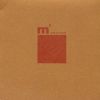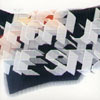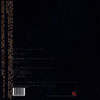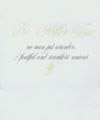 Mathis Mootz writes evil, destructive music that is fun in a devilishway. Under the guise of Panacea he has released some of the nastiest,heaviest, and most spectacularly dark recordings I've heard.Squaremeter has, on the other hand, been something of a detour: themusic is less rhythmic, more abstract, and not so much demented as itis creepy. The gap between these two monikers is beginning to close. War of Soundis an all-out melodic attack that churns out rhythmic pulses,middle-eastern flourishes, and an unrelenting air of doom. The entirealbum feels like a slow march through the desert. There are longstretches of beat-less music that are full of pulsing, Arabian-likesound. Once the tension has reached its boiling point, Mootz bringsdown his iron fist in subtle, measured movements. First comes thebouncing synthesizers moving in dramatic tonal shifts, then there's ahint of war-drums deep and full, and then all hell breaks loose. By thetime everything settles down there's already a counterstrike building.There is a continuity that runs through every track that supplies astrong thematic base. This allows for each song to build off theprevious one. Although nothing moves at a quick pace here, there is adensity to every second of sound that makes it feel powerful andcaustic. The vocal samples that run through it are a little annoying atfirst but with repeated listens they sink into and fit well with themusical themes. I think this album should come packaged with a viking'shelmet and a broadsword, though: Mootz's evil has sunk into my bones.
Mathis Mootz writes evil, destructive music that is fun in a devilishway. Under the guise of Panacea he has released some of the nastiest,heaviest, and most spectacularly dark recordings I've heard.Squaremeter has, on the other hand, been something of a detour: themusic is less rhythmic, more abstract, and not so much demented as itis creepy. The gap between these two monikers is beginning to close. War of Soundis an all-out melodic attack that churns out rhythmic pulses,middle-eastern flourishes, and an unrelenting air of doom. The entirealbum feels like a slow march through the desert. There are longstretches of beat-less music that are full of pulsing, Arabian-likesound. Once the tension has reached its boiling point, Mootz bringsdown his iron fist in subtle, measured movements. First comes thebouncing synthesizers moving in dramatic tonal shifts, then there's ahint of war-drums deep and full, and then all hell breaks loose. By thetime everything settles down there's already a counterstrike building.There is a continuity that runs through every track that supplies astrong thematic base. This allows for each song to build off theprevious one. Although nothing moves at a quick pace here, there is adensity to every second of sound that makes it feel powerful andcaustic. The vocal samples that run through it are a little annoying atfirst but with repeated listens they sink into and fit well with themusical themes. I think this album should come packaged with a viking'shelmet and a broadsword, though: Mootz's evil has sunk into my bones.
Look up Music for gazing upwards brought to you by Meat Beat Manifesto & scott crow, +/-, Aurora Borealis, The Veldt, Not Waving & Romance, W.A.T., The Handover, Abul Mogard & Rafael Anton Irisarri, Mulatu Astatke, Paul St. Hilaire & René Löwe, Songs: Ohia, and Shellac. Aurora Borealis image from California by Steve. Get involved: subscribe, review, rate, share with your friends, send images! |



 Forthis project, John Tejada eschews his current aural trends and DJ workto collaborate with Takeshi Nishimoto, with the former on drums, guitarand bass and the latter on guitar and bass. Their music isjazz-influenced in time signatures and tones, and the electronics areminimal, there for effect and a little flavoring only. Tejada is anextremely capable drummer—he learned how to play as a child. Together,he and Nishimoto lay down bass grooves that snake and hypnotize underintertwining guitar lines that dance around each other playfully, liketwo people on a first date trying to find the perfect opportunity forthat first kiss. "Jet Stream" opens the record with some clicks andburbles, and for a moment you think "Here we go again." The guitarleads you astray for a few seconds, but it's when the drums hit thatyou realize this is not the same ball of wax. The courtship of theguitars seems to be the centerpiece of this collaboration, as they takecenter stage on every track. Most tracks have a medium tempo, with onlya few powering their way through the speakers, and that's just the wayit should be. There's no need for hurry here, as both artists let theingredients delicately percolate into whatever it wants. Highlightsinclude "Search for Sleep," "Long Division," and the more electronic"Make Sense and Loose," which has some clever edits and effects. Everything at Oncecouldn't be a more appropriate title, as on their debut LP I'm Not aGun pull out all the stops, and show that there's nowhere for them togo but up.
Forthis project, John Tejada eschews his current aural trends and DJ workto collaborate with Takeshi Nishimoto, with the former on drums, guitarand bass and the latter on guitar and bass. Their music isjazz-influenced in time signatures and tones, and the electronics areminimal, there for effect and a little flavoring only. Tejada is anextremely capable drummer—he learned how to play as a child. Together,he and Nishimoto lay down bass grooves that snake and hypnotize underintertwining guitar lines that dance around each other playfully, liketwo people on a first date trying to find the perfect opportunity forthat first kiss. "Jet Stream" opens the record with some clicks andburbles, and for a moment you think "Here we go again." The guitarleads you astray for a few seconds, but it's when the drums hit thatyou realize this is not the same ball of wax. The courtship of theguitars seems to be the centerpiece of this collaboration, as they takecenter stage on every track. Most tracks have a medium tempo, with onlya few powering their way through the speakers, and that's just the wayit should be. There's no need for hurry here, as both artists let theingredients delicately percolate into whatever it wants. Highlightsinclude "Search for Sleep," "Long Division," and the more electronic"Make Sense and Loose," which has some clever edits and effects. Everything at Oncecouldn't be a more appropriate title, as on their debut LP I'm Not aGun pull out all the stops, and show that there's nowhere for them togo but up. The latest release from Norwegian supergroup Jaga Jazzist sees the much-anticipated follow up to last year's brilliant A Livingroom Hush with a slightly different approach. On The Stix,it would appear that more of the electronic elements on both theinstrumental and production sides have been employed, which in turncements the multi-layered, at times complex compositions. Opening withthe most interesting track I've heard in months, "Kitty Wu" blendsmelodic bass clarinet and vibraphone with dub bass lines, staccatoguitar and synth patches to drummer Martin Horntveth's programmed beatsand fusion-styled playing. "Another Day" is the perfect example of liveinstrument-augmented drum 'n bass with its plucked strings doubling thesyncopated rhythms for an interesting modal composition. The choppyAfro-Cuban groove interpretation of "Suomi Finland" is anchored byrolling vibraphone and warm bass sounds in which several differentmelodies are introduced on keyboard, flute and guitar throughoutvarious sections, eventually blending nicely into each other withoutbecoming a jumble. "Reminders" kicks off with busy, up-tempo drummingand half-time bass and vibes for subtle, muted trumpet to play off,which then grows into a full-sounding orchestration of horns and athick, multi-faceted rhythm section. The interestingly titled "I CouldHave Killed Him In The Sauna" moves from middle Eastern flavored pianoprogressions peppered with synth blips and scratchy beats to 70s progrock punches that are just this side of headbanging. Pretty, long-linedstrings, vibes, synth squelches and weaving, treated bass clarinet fillout the spaces and have one's jaw on the floor. Although the group'sname evokes the style of music in which instrumental soloists are theprime focus, such is not the case with Jaga Jazzist as they are amusical collective where the sum is greater than the individual parts.With such interesting compositions that marry up some creativeinstrumentation, several listens of The Stix are required to catch them all. -
The latest release from Norwegian supergroup Jaga Jazzist sees the much-anticipated follow up to last year's brilliant A Livingroom Hush with a slightly different approach. On The Stix,it would appear that more of the electronic elements on both theinstrumental and production sides have been employed, which in turncements the multi-layered, at times complex compositions. Opening withthe most interesting track I've heard in months, "Kitty Wu" blendsmelodic bass clarinet and vibraphone with dub bass lines, staccatoguitar and synth patches to drummer Martin Horntveth's programmed beatsand fusion-styled playing. "Another Day" is the perfect example of liveinstrument-augmented drum 'n bass with its plucked strings doubling thesyncopated rhythms for an interesting modal composition. The choppyAfro-Cuban groove interpretation of "Suomi Finland" is anchored byrolling vibraphone and warm bass sounds in which several differentmelodies are introduced on keyboard, flute and guitar throughoutvarious sections, eventually blending nicely into each other withoutbecoming a jumble. "Reminders" kicks off with busy, up-tempo drummingand half-time bass and vibes for subtle, muted trumpet to play off,which then grows into a full-sounding orchestration of horns and athick, multi-faceted rhythm section. The interestingly titled "I CouldHave Killed Him In The Sauna" moves from middle Eastern flavored pianoprogressions peppered with synth blips and scratchy beats to 70s progrock punches that are just this side of headbanging. Pretty, long-linedstrings, vibes, synth squelches and weaving, treated bass clarinet fillout the spaces and have one's jaw on the floor. Although the group'sname evokes the style of music in which instrumental soloists are theprime focus, such is not the case with Jaga Jazzist as they are amusical collective where the sum is greater than the individual parts.With such interesting compositions that marry up some creativeinstrumentation, several listens of The Stix are required to catch them all. -
 Far too much music being released these days seems to be utilitarian in nature. Albums are touted as "great driving music" or "after-club chillout music." I've actually heard certain critics suggest that an album is best heard in a particular time and setting: "Listen to this in the early morning hours after your girlfriend dumps you." Ever since Brian Eno developed the concept of ambient music, there seems to be a concerted effort to turn music into the equivalent of a backrub: something purely contextual that functions as an emotional salve if applied properly. Since the early 80's, Nurse With Wound has been pushing the opposite concept. Steven Stapleton's music is not made to make you feel better, or as something upbeat to play while doing crunches. Stapleton's music is designed for active, deep listening. You simply can't just play it in the background as you converse with friends. Even his most ambient pieces are not meditative; they are designed as a complex drama to make you FEEL something.
Far too much music being released these days seems to be utilitarian in nature. Albums are touted as "great driving music" or "after-club chillout music." I've actually heard certain critics suggest that an album is best heard in a particular time and setting: "Listen to this in the early morning hours after your girlfriend dumps you." Ever since Brian Eno developed the concept of ambient music, there seems to be a concerted effort to turn music into the equivalent of a backrub: something purely contextual that functions as an emotional salve if applied properly. Since the early 80's, Nurse With Wound has been pushing the opposite concept. Steven Stapleton's music is not made to make you feel better, or as something upbeat to play while doing crunches. Stapleton's music is designed for active, deep listening. You simply can't just play it in the background as you converse with friends. Even his most ambient pieces are not meditative; they are designed as a complex drama to make you FEEL something.
 It's hard to remember that the 1980's—usually thought of as the decadeof new wave, college rock and hair metal excess—was also the decade ofa vitally important generation of underground experimental musicians.Post-industrial, noise and audio surrealism flourished during the 80's,and labels like United Dairies and DOM were the primary outlet for thisunique crop of artists. A lot of this music has remained hopelesslyrare and unavailable on the digital format. Luckily, last year saw somere-releases of HNAS' classic back catalogue, but there is a lot stillleft untouched. Where are the CD reissues of the Nihilist Spasm Band,Asmus Tietchens, Robert Haigh, Uli Trepte, Masstishaddhu and TwoDaughters? How about Limpe Fuchs, Smegma and Algebra Suicide? Come onpeople, this is a goldmine of great musical esoterica! Now that I'mthrough ranting, I can revel in the fact that Roger Doyle's Silverdoorlabel has now re-released his United Dairies masterpiece. Rapid Eye Movementswas originally released under the artist name Operating Theatre in1981, and for me it is an unmatched classic of tape collage. Nokidding, I like to refer to this album as the "Citizen Kane" of musiqueconcrete. I first heard the United Dairies cassette nearly ten yearsago when a friend played it to me while I was in an altered state, andI was baffled and awed by this strange construction of disparateelements and bizarre sound effects. Later, I listened to it again andagain in an effort to decipher the seemingly narrative progression ofthe tape edits. The United Dairies release contained only two sidelongpieces: "Fin-Estra" and "Rapid Eye Movements." For this reissue,however, Roger Doyle has added two earlier pieces as a bonus: "ThePiano Suite" and "Why is Killkenny So Good?" The former is athree-part, impressionistic solo piano performance by Roger Doyle.While the music is nice enough, it really sticks out like a sore thumbsandwiched between two lengthy, atmospheric tape collage pieces. Nooffense to Mr. Doyle, but I don't think that the inclusion of thispiece was a very good idea. In contrast, "Killkenny" fits perfectly onthe disc, an eerie cut-up of a 13-year old drug addict describing hisaddiction as dimensional sounds swoop and mutate in the foreground."Fin-Estra" is a dark, mental voyage filled with unexpected drama. andDoyle utilizes sped up and slowed-down tape queuing in an ingenius way.The sounds of an orchestra, children at play, and strange alien tonesare juxtaposed. The 25 minutes of "Rapid Eye Movements" is my favoritemoment in avant-garde music. A man trudges through the snow screaming"Madeleine!", a room full of foreign shoolchildren recite words,someone plays scales on a lonely piano in an empty room. It's the auralequivalent of a disjointed, ephemoral dream, full of deja vu momentsthat seem even creepier and more evocative with each listen. I'm on atleast my 100th listen of Rapid Eye Movements, and it still hasn'tbecome boring or predictable.
It's hard to remember that the 1980's—usually thought of as the decadeof new wave, college rock and hair metal excess—was also the decade ofa vitally important generation of underground experimental musicians.Post-industrial, noise and audio surrealism flourished during the 80's,and labels like United Dairies and DOM were the primary outlet for thisunique crop of artists. A lot of this music has remained hopelesslyrare and unavailable on the digital format. Luckily, last year saw somere-releases of HNAS' classic back catalogue, but there is a lot stillleft untouched. Where are the CD reissues of the Nihilist Spasm Band,Asmus Tietchens, Robert Haigh, Uli Trepte, Masstishaddhu and TwoDaughters? How about Limpe Fuchs, Smegma and Algebra Suicide? Come onpeople, this is a goldmine of great musical esoterica! Now that I'mthrough ranting, I can revel in the fact that Roger Doyle's Silverdoorlabel has now re-released his United Dairies masterpiece. Rapid Eye Movementswas originally released under the artist name Operating Theatre in1981, and for me it is an unmatched classic of tape collage. Nokidding, I like to refer to this album as the "Citizen Kane" of musiqueconcrete. I first heard the United Dairies cassette nearly ten yearsago when a friend played it to me while I was in an altered state, andI was baffled and awed by this strange construction of disparateelements and bizarre sound effects. Later, I listened to it again andagain in an effort to decipher the seemingly narrative progression ofthe tape edits. The United Dairies release contained only two sidelongpieces: "Fin-Estra" and "Rapid Eye Movements." For this reissue,however, Roger Doyle has added two earlier pieces as a bonus: "ThePiano Suite" and "Why is Killkenny So Good?" The former is athree-part, impressionistic solo piano performance by Roger Doyle.While the music is nice enough, it really sticks out like a sore thumbsandwiched between two lengthy, atmospheric tape collage pieces. Nooffense to Mr. Doyle, but I don't think that the inclusion of thispiece was a very good idea. In contrast, "Killkenny" fits perfectly onthe disc, an eerie cut-up of a 13-year old drug addict describing hisaddiction as dimensional sounds swoop and mutate in the foreground."Fin-Estra" is a dark, mental voyage filled with unexpected drama. andDoyle utilizes sped up and slowed-down tape queuing in an ingenius way.The sounds of an orchestra, children at play, and strange alien tonesare juxtaposed. The 25 minutes of "Rapid Eye Movements" is my favoritemoment in avant-garde music. A man trudges through the snow screaming"Madeleine!", a room full of foreign shoolchildren recite words,someone plays scales on a lonely piano in an empty room. It's the auralequivalent of a disjointed, ephemoral dream, full of deja vu momentsthat seem even creepier and more evocative with each listen. I'm on atleast my 100th listen of Rapid Eye Movements, and it still hasn'tbecome boring or predictable.  After a week of spending some time almost every day listening to thisdouble CD set that compiles three previous releases by Icarus, thereare some bits that I've grown to really like quite a lot, but there arealso some bits that I like less with every listen. For example, thethree tracks from the UL-6 EP (originallyreleased on Output Recordings in 2001) that take up a good chunk of thefirst disc are initially quite impressive in their complexity,featuring off-kilter combinations of scattershot breakbeats and soundsthat seem like the final creaks and clanks of dying machinery. Onrepeated listens, that complexity begins to take on an air of aimlessnoodling, especially on the track "UL-6" which could definitely bear abit of shaving down from its 10+ minutes. Disc one is saved, however,by the excellent pair of closing tracks (taken from last year's Soviet Igloo12") which tone down the hyperactive elements and bring in a melodicside that bears some resemblance to Telefon Tel Aviv. The entirety ofdisc two is taken up by the 2002 album Misfits (previouslyavailable on the Not Applicable label), and the six tracks manage tostrike a decent balance between the skittery-clattery bits and themellow-melodic bits. Aside from one lovely track that appears to becalled "Xot Zioks" (sorry, the track listing is really small and in afucked up font), none of it is quite as pleasing to my ears as thosetwo Soviet Igloo tracks from the first disc. I also can't helpbut wonder—considering that the eleven tracks on this release have atotal combined length of around 75 minutes—why did this have to be adouble disc?
After a week of spending some time almost every day listening to thisdouble CD set that compiles three previous releases by Icarus, thereare some bits that I've grown to really like quite a lot, but there arealso some bits that I like less with every listen. For example, thethree tracks from the UL-6 EP (originallyreleased on Output Recordings in 2001) that take up a good chunk of thefirst disc are initially quite impressive in their complexity,featuring off-kilter combinations of scattershot breakbeats and soundsthat seem like the final creaks and clanks of dying machinery. Onrepeated listens, that complexity begins to take on an air of aimlessnoodling, especially on the track "UL-6" which could definitely bear abit of shaving down from its 10+ minutes. Disc one is saved, however,by the excellent pair of closing tracks (taken from last year's Soviet Igloo12") which tone down the hyperactive elements and bring in a melodicside that bears some resemblance to Telefon Tel Aviv. The entirety ofdisc two is taken up by the 2002 album Misfits (previouslyavailable on the Not Applicable label), and the six tracks manage tostrike a decent balance between the skittery-clattery bits and themellow-melodic bits. Aside from one lovely track that appears to becalled "Xot Zioks" (sorry, the track listing is really small and in afucked up font), none of it is quite as pleasing to my ears as thosetwo Soviet Igloo tracks from the first disc. I also can't helpbut wonder—considering that the eleven tracks on this release have atotal combined length of around 75 minutes—why did this have to be adouble disc? Nothing musical has ever made me dizzy like this before. I don't knowif I was just tired, if it was the music, or maybe a combination of thetwo but it's doing it again now. The walls were wavering and I felt asif I were suffocating, the light that should've been filtering throughthe curtains from outside were swallowed up by the sound. I'm feelingsick. My skin is crawling, I can't keep my eyes focused and my headsimply won't hold up any longer. My skin itches; there's somethingunder my skin and it fucking itches. I look at the clock and it's 3:30in the morning. Ten minutes later I look again and it's 4:30. I'mlosing my mind. I try to stand up but sitting back down seems like thebest idea. There's something crawling up the back of my neck and Ican't quite swat it away. There's lots of them, they're biting, and nowmy eyes are closing. I can't go to sleep but I want to, desperately. Myarms are getting heavy, it's harder to breathe, my shoulders and backare starting to throb and ache. I know there's light in this room but Ican't feel it or see it. I'm getting paranoid, I want to scream butwhen my mouth opens there's no sound. Then it's gone. I can breathe,the sun is rising up over the trees in my backyard and I suddenlyrealize that I'm sitting on the floor and not in a chair at all. I feelmore awake; every sound in the room is amplified a thousand times,however. The hum of my computer is more obvious, the wind outside isdisasterous, when I take a drink of water it is almost deafening. I didnot go to sleep easily last night, the incessant chirping of the birdskept me awake until fatigue pushed me under. Now I'm going back to itlike a little fiend. The lights are out and I'm breathing heavilyagain.
Nothing musical has ever made me dizzy like this before. I don't knowif I was just tired, if it was the music, or maybe a combination of thetwo but it's doing it again now. The walls were wavering and I felt asif I were suffocating, the light that should've been filtering throughthe curtains from outside were swallowed up by the sound. I'm feelingsick. My skin is crawling, I can't keep my eyes focused and my headsimply won't hold up any longer. My skin itches; there's somethingunder my skin and it fucking itches. I look at the clock and it's 3:30in the morning. Ten minutes later I look again and it's 4:30. I'mlosing my mind. I try to stand up but sitting back down seems like thebest idea. There's something crawling up the back of my neck and Ican't quite swat it away. There's lots of them, they're biting, and nowmy eyes are closing. I can't go to sleep but I want to, desperately. Myarms are getting heavy, it's harder to breathe, my shoulders and backare starting to throb and ache. I know there's light in this room but Ican't feel it or see it. I'm getting paranoid, I want to scream butwhen my mouth opens there's no sound. Then it's gone. I can breathe,the sun is rising up over the trees in my backyard and I suddenlyrealize that I'm sitting on the floor and not in a chair at all. I feelmore awake; every sound in the room is amplified a thousand times,however. The hum of my computer is more obvious, the wind outside isdisasterous, when I take a drink of water it is almost deafening. I didnot go to sleep easily last night, the incessant chirping of the birdskept me awake until fatigue pushed me under. Now I'm going back to itlike a little fiend. The lights are out and I'm breathing heavilyagain.  Tindersticks' first two albums, which appeared in the early 1990s, weremarked by an uncommon emotional rawness and seductive melancholy.Tracks like "A Night In" and "Tiny Tears" with their epicorchestrations and Stuart Staples' brooding croon rank alongside someof the better works of Nick Cave and Scott Walker. The albumssubsequent to their first two eponymous records, like Curtains and Can Our Love,contain occassional moments of that intial brilliance, but overall, theheart-wrenching, visceral gutsiness that once dominated their workbegan to fade. On Waiting for the Moon, their sixth album, itis all but gone. Tindersticks have seemed to lapse into the sameself-satisfied, vanilla territory of chamber pop as radio-friendlybands like Cousteau. The twangy guitar and insipid lyrics on thealbum's opening track, "Until the Morning Comes" set the uninpsiredtone. Even Stuart's voice sounds like a washed-out shadow of what itonce was. "Say Goodbye To the City," despite its crescendo towards theend, ultimately goes nowhere. Tindersticks have reached the point atwhich they've begun to sound as if they've run out of ideas. Despitethe fact that they thump out albums at a regular pace, it seems as ifthey would serve themselves better by taking time to re-evaluate theirdirection (or lack thereof). I was shocked to read that the pressrelease for Waiting for the Moon touted: "more sonicexplorations in sound" and a return to their "experimental" roots,because those statements couldn't be further from the truth.
Tindersticks' first two albums, which appeared in the early 1990s, weremarked by an uncommon emotional rawness and seductive melancholy.Tracks like "A Night In" and "Tiny Tears" with their epicorchestrations and Stuart Staples' brooding croon rank alongside someof the better works of Nick Cave and Scott Walker. The albumssubsequent to their first two eponymous records, like Curtains and Can Our Love,contain occassional moments of that intial brilliance, but overall, theheart-wrenching, visceral gutsiness that once dominated their workbegan to fade. On Waiting for the Moon, their sixth album, itis all but gone. Tindersticks have seemed to lapse into the sameself-satisfied, vanilla territory of chamber pop as radio-friendlybands like Cousteau. The twangy guitar and insipid lyrics on thealbum's opening track, "Until the Morning Comes" set the uninpsiredtone. Even Stuart's voice sounds like a washed-out shadow of what itonce was. "Say Goodbye To the City," despite its crescendo towards theend, ultimately goes nowhere. Tindersticks have reached the point atwhich they've begun to sound as if they've run out of ideas. Despitethe fact that they thump out albums at a regular pace, it seems as ifthey would serve themselves better by taking time to re-evaluate theirdirection (or lack thereof). I was shocked to read that the pressrelease for Waiting for the Moon touted: "more sonicexplorations in sound" and a return to their "experimental" roots,because those statements couldn't be further from the truth. 
